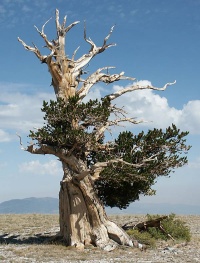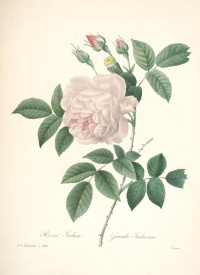Botany
From The Art and Popular Culture Encyclopedia

The 49th plate from Ernst Haeckel's Kunstformen der Natur of 1904, showing various sea anemones classified as Actiniae.


|
Related e |
|
Featured: |
Botany, plant science(s), phytology, or plant biology is a branch of biology and is the scientific study of plant life and development. Botany covers a wide range of scientific disciplines that study plants, algae, and fungi including: structure, growth, reproduction, metabolism, development, diseases, and chemical properties and evolutionary relationships between the different groups. Botany, the study of plants, began with tribal efforts to identify edible, medicinal and poisonous plants, making botany one of the oldest sciences. From this ancient interest in plants, the scope of botany has increased to include the study of over 550,000 kinds or species of living organisms.
Contents |
History
Early botany
- Ancient India
Early examples of plant taxonomy occur in the Rigveda, that divides plants into Vṛska (tree), Osadhi (herbs useful to humans) and Virudha (creepers). which are further subdivided. The Atharvaveda divides plants into eight classes, Visakha (spreading branches), Manjari (leaves with long clusters), Sthambini (bushy plants), Prastanavati (which expands); Ekasṛnga (those with monopodial growth), Pratanavati (creeping plants), Amsumati (with many stalks), and Kandini (plants with knotty joints). The Taittiriya Samhita and classifies the plant kingdom into vṛksa, vana and druma (trees), visakha (shrubs with spreading branches), sasa (herbs), amsumali (a spreading or deliquescent plant), vratati (climber), stambini (bushy plant), pratanavati (creeper), and alasala (those spreading on the ground).
Manusmriti – Law book of Hindus – proposed a classification of plants in eight major categories. Charaka Samhitā and Sushruta Samhita and the Vaisesikas also present an elaborate taxonomy.
Parashara, the author of Vṛksayurveda (the science of life of trees), classifies plants into Dvimatrka (Dicotyledons) and Ekamatrka (Monocotyledons). These are further classified into Samiganiya (Fabaceae), Puplikagalniya (Rutaceae), Svastikaganiya (Cruciferae), Tripuspaganiya (Cucurbitaceae), Mallikaganiya (Apocynaceae), and Kurcapuspaganiya (Asteraceae).
Important medieval Indian works of plant physiology include the Prthviniraparyam of Udayana, Nyayavindutika of Dharmottara, Saddarsana-samuccaya of Gunaratna, and Upaskara of Sankaramisra.
- Ancient China
In ancient China, the recorded listing of different plants and herb concoctions for pharmaceutical purposes spans back to at least the Warring States (481 BC-221 BC). Many Chinese writers over the centuries contributed to the written knowledge of herbal pharmaceutics. There was the Han Dynasty (202 BC-220 AD) written work of the Huangdi Neijing and the famous pharmacologist Zhang Zhongjing of the 2nd century. There was also the 11th century scientists and statesmen Su Song and Shen Kuo, who compiled treatises on herbal medicine and included the use of mineralogy.
- Greco-Roman world
Among the earliest of botanical works in Europe, written around 300 B.C., are two large treatises by Theophrastus: On the History of Plants (Historia Plantarum) and On the Causes of Plants. Together these books constitute the most important contribution to botanical science during antiquity and on into the Middle Ages. Aristotle also wrote about plants.
The Roman medical writer Pedanius Dioscorides (ca.40-90) provides important evidence on Greek and Roman knowledge of medicinal plants. Dioscorides is famous for writing a five volume book in his native Greek Περί ύλης ιατρικής (De Materia Medica - in the latin translation) that is one of the most influential herbal books in history. In fact it remained in use until about CE 1600. Approximately 1300-1400 different plant species were known under Roman reign.
Medieval botany
The Kurdish biologist Al-Dinawari (828-896) is considered the founder of Arabic botany for his Book of Plants, in which he described at least 637 plants and discussed plant evolution from its birth to its death, describing the phases of plant growth and the production of flowers and fruit.
Theophrastus’s Historia Plantarum served as a reference point in botany for many centuries, and was further developed around 1200 by Giovanni Bodeo da Stapelio, who added a commentarius and drawings: see Historia Plantarum —Selected pages of a 17th century edition of the 1200 version (in Italian).
In the early 13th century, the Andalusian-Arabian biologist Abu al-Abbas al-Nabati developed an early scientific method for botany, introducing empirical and experimental techniques in the testing, description and identification of numerous materia medica, and separating unverified reports from those supported by actual tests and observations. His student Ibn al-Baitar (d. 1248) wrote a pharmaceutical encyclopedia describing 1,400 plants, foods, and drugs, 300 of which were his own original discoveries. A Latin translation of his work was useful to European biologists and pharmacists in the 18th and 19th centuries.
Early modern botany
German physician Leonhart Fuchs (1501–1566) was one of the three founding fathers of botany, along with Otto Brunfels (1489- 1534) and Hieronymus Bock (1498-1554) (also called Hieronymus Tragus).
Valerius Cordus (1515–1554) authored one of the greatest pharmacopoeias and one of the most celebrated herbals in history, Dispensatorium (1546). As early as the 16th century, the Italian Ulisse Aldrovandi was scientifically researching plants. In 1665, using an early microscope, Robert Hooke discovered cells in cork, and a short time later in living plant tissue. The Germans Jakob Theodor and Leonhart Fuchs, the Swiss Conrad von Gesner, and the British authors Nicholas Culpeper and John Gerard published herbals that gave information on the medicinal uses of plants.
During the 18th century systems of classification became deliberately artificial and served only for the purpose of identification. These classifications are comparable to diagnostic keys, where taxa are artificially grouped in pairs by few, easily recognisable characters. The sequence of the taxa in keys is often totally unrelated to their natural or phyletic groupings. In the 18th century an increasing number of new plants had arrived in Europe, from newly discovered countries and the European colonies worldwide, and a larger amount of plants became available for study.
In 1754 Carl von Linné (Carl Linnaeus) divided the plant Kingdom into 25 classes. One, the Cryptogamia, included all the plants with concealed reproductive parts (algae, fungi, mosses and liverworts and ferns).
The increased knowledge on anatomy, morphology and life cycles, lead to the realization that there were more natural affinities between plants, than the sexual system of Linnaeus indicated. Adanson (1763), Jussieu (1789), and Candolle (1819) all proposed various alternative natural systems that were widely followed. The ideas of natural selection as a mechanism for evolution required adaptations to the Candollean system, which started the studies on evolutionary relationships and phylogenetic classifications of plants.
Modern botany
A considerable amount of new knowledge today is being generated from studying model plants like Arabidopsis thaliana. This weedy species in the mustard family was one of the first plants to have its genome sequenced. The sequencing of the rice (Oryza sativa) genome and a large international research community have made rice the de facto cereal/grass/monocot model. Another grass species, Brachypodium distachyon is also emerging as an experimental model for understanding the genetic, cellular and molecular biology of temperate grasses. Other commercially-important staple foods like wheat, maize, barley, rye, pearl millet and soybean are also having their genomes sequenced. Some of these are challenging to sequence because they have more than two haploid (n) sets of chromosomes, a condition known as polyploidy, common in the plant kingdom. Chlamydomonas reinhardtii (a single-celled, green alga) is another plant model organism that has been extensively studied and provided important insights into cell biology.
In 1998 the Angiosperm Phylogeny Group published a phylogeny of flowering plants based on an analysis of DNA sequences from most families of flowering plants. As a result of this work, major questions such as which families represent the earliest branches in the genealogy of angiosperms are now understood. Investigating how plant species are related to each other allows botanists to better understand the process of evolution in plants.
See also
- Bibliography of biology
- Botanical garden and List of botanical gardens
- Botanical illustration
- Dendrochronology
- Edible Flowers
- Flowers and List of flowers
- Genomics of domestication
- Herbs
- Herbchronology
- History of plant systematics
- History of phycology
- List of botanical journals
- List of botanists
- List of Russian botanists
- List of botanists by author abbreviation
- List of domesticated plants
- List of systems of plant taxonomy
- Plant community
- Plant sexuality
- Seeds
- Soil science
- Trees
- Vegetation
- Weed science
- Zoology
Further reading
- Bloom: The Botanical Vernacular in the English Novel (2003) is a book by Amy M. King.

